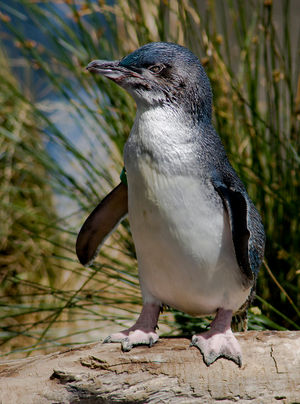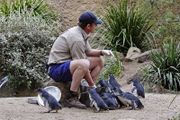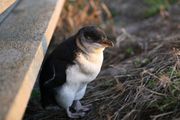Little Penguin
| Little Penguin | |
|---|---|
 |
|
| Melbourne Zoo, Victoria, Australia. | |
| Conservation status | |
| Scientific classification | |
| Kingdom: | Animalia |
| Phylum: | Chordata |
| Class: | Aves |
| Order: | Sphenisciformes |
| Family: | Spheniscidae |
| Genus: | Eudyptula |
| Species: | E. minor |
| Binomial name | |
| Eudyptula minor (J.R.Forster, 1781) |
|
 |
|
| The Range of the Little Penguin Subspecies separated by Lines |
|
The Little Penguin (Eudyptula minor) is the smallest species of penguin. The penguin, which is about 43 cm (16 in) tall, is found on the coastlines of southern Australia and New Zealand, with possible records from Chile.
Apart from Little Penguins, they have several common names. In Australia, they are also referred to as Fairy Penguins because of their tiny size. In New Zealand, they are also called Little Blue Penguins, or just Blue Penguins, owing to their slate-blue plumage, and they are called Kororā in Māori.
Contents |
Taxonomy
The Little Penguin was first described by German naturalist, Johann Reinhold Forster in 1781. There are several subspecies but a precise classification of these is still a matter of dispute. The holotypes of the subspecies Eudyptula minor variabilis[2] and Eudyptula minor chathamensis[3] are in the collection of the Museum of New Zealand Te Papa Tongarewa. The White-flippered Penguin is sometimes considered a subspecies, sometimes a distinct species, and sometimes a morph. As the Australian and western South Island Little Penguins seem to be a distinct species[4] to which the specific name minor would apply, the White-flippered birds indeed belong to a distinct species, although not exactly as originally assumed.
Mitochondrial and nuclear DNA evidence suggests the split between Eudyptula and Spheniscus occurred around 25 million years ago, with the ancestors of the White-flippered and Little Penguins diverging about 2.7 million years ago.[5]
Description
The Little Penguin typically grows to 43 cm (17 in) tall and weigh 1 kilogram (2.2 pounds). The male fairy penguin is a little larger than the female, although their plumage is similar. The head and upperparts are indigo in colour, with slate-grey ear coverts fading to white underneath, from the chin to the belly. The flippers are indigo above and white underneath. The dark grey-black bill is 3–4 cm long, the irises pale silvery- or bluish-grey or hazel, and the feet whitish above with black soles and webbing. An immature individual will have a shorter bill and paler upperparts.[6]
Like most seabirds, they have a long lifespan. The average for the species is 6.5 years, but flipper ringing experiments show 20 years.[7]
 Chick in nest burrow |
 Little penguins at the Melbourne Zoo |
_-Adelaide_Zoo.jpg) Little penguin at the Adelaide Zoo, in Adelaide, South Australia, Australia. |
Distribution and habitat
The Little Penguin breeds along the entire coastline of New Zealand, the Chatham Islands, the Babel Island (20,000 pairs), Tasmania, and southern Australia. It is also found in the Genoa River.
Little penguins have also been reported from Chile (where they are known as Pingüino pequeño or Pingüino azul) (Isla Chañaral 1996, Playa de Santo Domingo, San Antonio, 16 March 1997) and South Africa, but it is unclear whether these birds were vagrants.
Behaviour
Diet
These birds feed by hunting fish, squid and other small sea animals, for which they travel and dive quite extensively. They are generally inshore feeders.[8] The use of dataloggers has provided information of the diving behaviour of Little Penguins. 50% of their dives go no deeper than 2 m and the mean diving time is 21 seconds.[9]. Yet, they are able to dive as deep as 66.7m and remained submerged as long as 90 sec.[10].
Reproduction
Little Penguins begin breeding at the age of three or four. They are monogamous and remain faithful to their partner over successive years[11], though they will find another mate if their current one dies. They also exhibit site fidelity to their nesting colonies and nesting sites over successive years.
Little Penguins live year-round in large colonies, with each individual breeding pair forming a burrow in which to raise their chicks (of which two are born at a time). Little Penguins typically return to their colonies to feed their chicks at dusk. The birds will tend to come ashore in small groups to provide some defense against predators which might pick off individuals one by one. In Australia, the strongest colonies are on cat-free and fox-free islands.
Relationship with humans

South of Perth, Western Australia, visitors to Penguin Island are able to view penguins in a totally natural state. Less than one hour from the centre of the city it is possible to see Little Penguins in all months, including visiting sensitive areas where they remain on land for extended periods for the purposes of moulting.
At Phillip Island, southeast of Melbourne, a viewing area has been set up at the Phillip Island Nature Park to allow tourists to view the nightly "penguin parade". Lights and concrete stands have been erected to allow visitors to see but not photograph the birds interacting in their colony, who are not bothered by their spectators. The "parade", which stands as a very popular attraction, brings half a million visitors a year.[12] Visitors to Kangaroo Island, South Australia, have the nightly opportunity to commune with penguins at the Kangaroo Island Marine Centre in Kingscote and at the Penneshaw Penguin Centre.[13]
Several human-made enclosures have been made to support breeding and shelter, with several people clearing an area for the penguins and burying the huts, most notably The Knox School, when their efforts were filmed and broadcast in 2008 by Totally Wild.
The Oamaru Blue Penguin Colony[14] is the New Zealand equivalent to Phillip Island's penguin parade.
Mascots and logos
Linus Torvalds, the original creator of Linux (a popular operating system kernel), was once bitten by a Little Penguin while on holiday in Australia. Reportedly, this encounter encouraged Torvalds to select Tux as the official Linux mascot.[15]
Penny the Little Penguin was the mascot for the 2007 FINA World Swimming Championships held in Melbourne, Victoria.[16][17]
Sea World

There is a colony of Little Penguins at Sea World, on the Gold Coast, in Queensland, Australia. In early March, 2007, 25 of the 37 penguins died from an unknown toxin following a change of gravel in their enclosure.[18][19][20] It is still not known what caused the deaths of the Little Penguins, and it was decided not to return the 12 surviving penguins to the same enclosure in which the penguins became ill.[21]
A new enclosure for the Little Penguin colony was opened at Sea World in 2008.
Predators
.jpg)
St Kilda breakwater
Little Penguins in the wild are sometimes preyed upon by New Zealand fur seals. A study done by researchers from the South Australian Research and Development Institute (based at the Waite campus of the University of Adelaide) found that roughly 40 percent of seal droppings in South Australia's Granite Island area contained Little Penguin remains. [22][23]
Little Penguins on Middle Island in Warrnambool, Victoria were subject to heavy predation by foxes, which could reach the island at low tide by a tidal sand bridge. The deployment of Maremma sheepdogs to protect the penguin colony has deterred the foxes and enabled the penguin population to rebound.[24] This is in addition to the support from groups of volunteers who work to protect the penguins from attack at night.
In Sydney, snipers have been deployed to protect a colony of Little Penguins.[25] This effort is in addition to support from local volunteers who work to protect the penguins from attack at night.
References
- ↑ BirdLife International (2004). Eudyptula minor. 2006. IUCN Red List of Threatened Species. IUCN 2006. www.iucnredlist.org. Retrieved on 9 May 2006.
- ↑ "Eudyptula minor variabilis; holotype". Collections Online. Museum of New Zealand Te Papa Tongarewa. http://collections.tepapa.govt.nz/objectdetails.aspx?oid=416404. Retrieved 17 July 2010.
- ↑ "Eudyptula minor chathamensis; holotype". Collections Online. Museum of New Zealand Te Papa Tongarewa. http://collections.tepapa.govt.nz/objectdetails.aspx?oid=421788. Retrieved 17 July 2010.
- ↑ Banks, Jonathan C.; Mitchell, Anthony D.; Waas, Joseph R. & Paterson, Adrian M. (2002): An unexpected pattern of molecular divergence within the blue penguin (Eudyptula minor) complex. Notornis 49(1): 29–38. PDF fulltext
- ↑ Baker AJ, Pereira SL, Haddrath OP, Edge KA (2006). "Multiple gene evidence for expansion of extant penguins out of Antarctica due to global cooling". Proc Biol Sci. 273 (1582): 11–17. doi:10.1098/rspb.2005.3260. PMID 16519228. PMC 1560011. http://www.pubmedcentral.nih.gov/articlerender.fcgi?artid=1560011. Retrieved 2008-03-21.
- ↑ Williams (The Penguins) p. 230
- ↑ Dann, P. et al. (2005): Longevity in Little Penguins. Marine Ornithology 33: 71–72. PDf fulltext
- ↑ Numata, M; Davis, L & Renner, M (2000) "Prolonged foraging trips and egg desertion in little penguins (Eudyptula minor)". New Zealand Journal of Zoology 27: 291-298
- ↑ Bethge, P; Nicol, S; Culik, BM & RP Wilson (1997) "Diving behaviour and energetics in breeding little penguins (Eudyptula minor)". Journal of Zoology 242: 483-502
- ↑ Ropert-Coudert Y, Chiaradia A, Kato A (2006) "An exceptionally deep dive by a Little Penguin Eudyptula minor". Marine Ornithology 34: 71-74
- ↑ Bull, L (2000) "Fidelity and breeding success of the blue penguin Eudyptula minor on Matiu-Somes Island, Wellington, New Zealand". New Zealand Journal of Zoology 27: 299-304
- ↑ Visit Victoria, Phillip Island
- ↑ Penneshaw Penguin Centre
- ↑ Oamaru Blue Penguin Colony
- ↑ ""Tux" the Aussie Penguin". Linux Australia. http://www.linux.org.au/linux/tux. Retrieved 2006-06-25.
- ↑ FINA - Melbourne, 2007
- ↑ Protecting our Little Penguins (Victorian Government website)
- ↑ Mystery illness kills at least 24 penguins at Sea World
- ↑ Authorities find unknown toxin in Sea World Penguins
- ↑ Sea World probes mysterious deaths
- ↑ Penguin deaths remain a mystery
- ↑ Penguins —Environment, South Australian Government
- ↑ Littlely, Bryan (2007-10-10). "Fur seals threat to Granite Island penguins". The Advertiser: pp. 23
- ↑ "Dogs come to fairy penguins' rescue". Special Broadcasting Service. 5 January 2009. http://www.sbs.com.au/news/article/1004160/Dogs-come-to-fairy-penguins%27-rescue. Retrieved 2009-01-07.
- ↑ "Penguin murders prompt sniper aid". BBC. 16 July 2009. http://news.bbc.co.uk/2/hi/asia-pacific/8153168.stm. Retrieved 2009-07-16.
Cited text
- Williams, Tony D. (1995). The Penguins. Oxford, England: Oxford University Press. ISBN 0-19-854667-X.
External links
- More Information on Little penguins @ New Zealand Penguins
- Little penguins from the International Penguin Conservation Web Site
- Philip Island Nature Park Web Site
- Gould's The Birds of Australia plate
- Fairy Penguin on Google Video
- Roscoe, R. "Little (Blue) Penguin". Photo Volcaniaca. http://www.photovolcanica.com/PenguinSpecies/Little/LittlePenguinPhotos.html. Retrieved 13 April 2008.
|
|||||||||||||||||||||||
